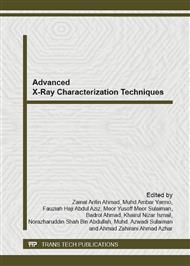p.122
p.127
p.132
p.137
p.142
p.147
p.151
p.156
p.161
Intermetallic Evolution of Sn-3.5Ag-1.0Cu-0.1Zn/Cu Interface under Thermal Aging
Abstract:
Due to environmental concerns, lead-free solders were introduced in replacing the lead-based solders in microelectronics devices technology. Although there are many lead-free solder available, the Sn-Ag-Cu is considered the best choice. But the solder has its draw backs in terms of melting temperature and intermetallic formations. To improve the solder, a fourth element Zn was added into the solder. The new composite solders were synthesized via powder metallurgy route. This research studies the effect of 0.1wt% Zn addition on the hardness and intermetallic formation on Cu substrate. For the hardness results, the micro Vickers values were reported. For intermetallic, the solders were melted at 250°C and aged at 150°C until 400 hours. The microhardness value for Zn based composites solder shows higher micro Vickers hardness compared to un-doped counterparts. The phases formed and its growth was studied under SEM and by energy dispensive x-ray (EDX). The SEM results show the presence of Cu6Sn5 and Cu3Sn intermetallics and the Cu5Zn8 intermetallic was not detected. The addition of 0.1wt% Zn has retarded the growth of the Cu3Sn intermetallic but not the total intermetallic thickness.
Info:
Periodical:
Pages:
142-146
Citation:
Online since:
December 2012
Price:
Сopyright:
© 2013 Trans Tech Publications Ltd. All Rights Reserved
Share:
Citation:


